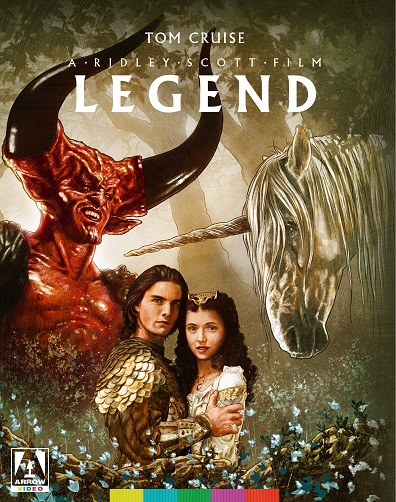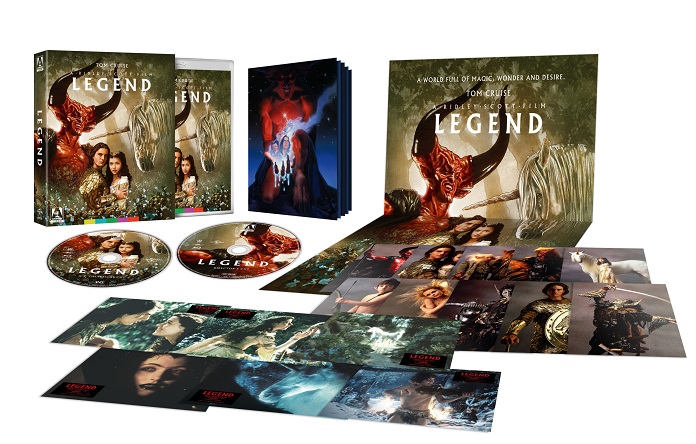
Legend
Studio: Arrow Video
Oct 29, 2021
Web Exclusive
![]()
Long ago in a fantastical world, unicorns roamed the forest. They were the protectors of light, and all that is good and pure in the universe. Hunted and hated by the Lord of Darkness, their presence was the only thing preventing the world from falling into an eternal winter.
Jack (Tom Cruise) is a child of the forest, a friend to all of the incredible creatures that dwell in it. He’s loved deeply by Lili (Mia Sara), a young maiden who visits him in the woods. Only wishing to share the unicorns’ beauty with her, Jack breaks the cardinal rule of their land: when the mortal Lily lays hands upon the creature, minions of Darkness descend, and kill one of the two remaining unicorns.
Its death throws their land into chaos, as a deep freeze covers the forest. The two lovers are separated, and soon realize they may be the only ones who can stop Darkness (Tim Curry) from blotting the sun from the sky forever. With the help of a fairy and forest folk, Jack heads into Hell on a quest to save the last living unicorn, and find his beloved Lili.
Legend (1985) is the most lavish of the films to come from the fantasy boom of the mid-1980s. It’s an absolutely gorgeous movie: a dark fairy tale with an often surreal, dreamlike vibe. It’s probably best remembered for Tim Curry’s devilish performance as Darkness; even under several metric tons of makeup and prosthetics—courtesy of the great Rob Bottin, effects king on The Thing (1982)—Curry brings his signature theatricality to the role. It’s also a minor masterpiece of production design, as the team built not only a memorable Hades, but an entire fantasy forest from the ground up, and inside a sound stage. Viewing the film in high definition, it’s even harder to believe they weren’t filming on real streams and waterfalls in an untouched European forest—that’s how good this film looks. If the movie hadn’t been so critically maligned, it would/should have been up for every design-related Academy Award.
In the filmography of director Ridley Scott, Legend (1985) directly followed Alien and Blade Runner—how’s that for a hot streak? Heavily hyped in the genre mags of the era, the movie proved to be a very expensive flop—due in part to a delayed release that saw two separate, heavily cut versions hitting theaters, and also to the movie seeming like it had little idea what audience it was being made for. It’s a movie that’s far too scary for most children, but with humor—particularly, the goblin and dwarf characters—that at times feels like it was written for a broader, family audience. Adding to this confusion, when Universal re-cut the film for release in the United States, they shifted the focus to its young stars in an attempt to turn it into a romantic tale for teenagers—even though the characters spend the majority of the film apart. (Ironically, the American release of Legend was unceremoniously shooed out of theaters to make room for Cruise’s blockbuster Top Gun, which was directed by Ridley’s brother, Tony, and arrived a few weeks later.)
Ridley Scott is probably more closely associated with “Director’s Cuts” and alternate versions of his films than any other filmmaker. Though not as famous as the differing versions of Blade Runner or Kingdom of Heaven, the changes made to Scott’s Legend are easily as drastic as those. Arrow’s deluxe Blu-ray edition of the film includes two of the three best-known cuts of the film, but they’re far and away the most different from one another. One of these is, in fact, Scott’s cut of the film—clocking in at 113 minutes, much longer than any version widely released in theaters. The other is the U.S. theatrical cut, which is the version most American fans grew up with: at 90 minutes, it was the version released on home video here for the first seventeen years of the movie’s lifetime. If you’re a Legend fan and haven’t yet experienced both versions, well, that’s worth the price of admission alone, because they couldn’t be more different.
Scott’s longer director’s cut adds more than 20 minutes of footage to the film, while subtracting little bits and pieces that were included in the shorter versions of Legend. Unsurprisingly, this version of the story is far more fleshed out—we learn a lot more about the characters, and some of their actions make a lot more sense when given more context. Almost every scene is a little bit longer; the story more closely follows the quest to save the unicorn (and the world) while the relationship between Jack and Lili is pushed to the side. Lili sings a song to the unicorn before it’s killed, and is portrayed as more of a troublemaker than she is in the American version. Compared to this, the American cut just flies in terms of pacing, as we get almost all of the same scenes, but truncated.
Outside of all the extra footage, the main difference between these two cuts is the music. Scott’s cut of the movie as well as the European theatrical version—which couldn’t be included here because of rights issues—are scored by Jerry Goldsmith. Meanwhile, the American cut was scored by Tangerine Dream, and featured songs from Bryan Ferry and Yes’s Jon Anderson. If you’re familiar with both Goldsmith’s orchestral soundtracks and Tangerine Dream’s synthesizer scores, you can probably already hear the vast difference between their styles in your head. Goldsmith’s score is good enough, don’t get me wrong—it is Jerry flippin’ Goldsmith, after all—but it feels very traditional. It can make Legend feel like a much more run-of-the-mill fantasy adventure. On the other hand, Tangerine Dream’s score better plays into the strange dreamlike quality of the movie, and is unique for the film’s genre and era.
So, which version is better? Story-wise, it’s Ridley’s cut, but musically we have to side with the American theatrical cut. Which would we rather watch? The American cut, probably because it’s the one we grew up with, and while the director’s version answers some questions left hanging in the shorter versions, they’re question we didn’t necessarily feel we needed answers for to enjoy the movie. Fortunately both are available here, and you can make that choice for yourself.

Arrow’s limited edition Blu-ray of the movie is overloaded with extras, both new and carried over from previous releases. There are featurettes on the music, makeup effects, and art production—this latter version details how the massive forest set went up in flames partway into the shoot, and had to be rebuilt from scratch while shooting continued around it. There’s also a detailed video breaking down the differences between the various versions of the movie. There are audio commentaries, music videos, a vintage documentary about the making of the film that features the primary cast and crew, alternate openings, image galleries, screenplays, TV spots and trailers, an isolated Tangerine Dream score, a thick booklet of essays, a poster, and two different sets of lobby card reproductions. It’s insane how stocked this slipcase is. If you’re a fan of Legend, there shouldn’t be anything holding you back from picking up this release.
(mvdshop.com/products/legend-limited-edition-blu-ray)
Current Issue

Issue #72
Apr 19, 2024 Issue #72 - The ‘90s Issue with The Cardigans and Thurston Moore
Most Recent
- 12 Best Songs of the Week: Charly Bliss, Jessica Pratt, The WAEVE, Hamish Hawk, and More (News) —
- John Carpenter on ‘Lost Themes IV: Noir’ (Interview) —
- Thomas Powers (of The Naked & Famous) Shares New Single, “Empty Voices” feat. Julien Baker (News) —
- illuminati hotties Shares Video for New Song “Can’t Be Still” and Announces New Tour Dates (News) —
- Jordan Lindley Shares New Single “Sometime Someday” (News) —

Comments
Submit your comment
There are no comments for this entry yet.